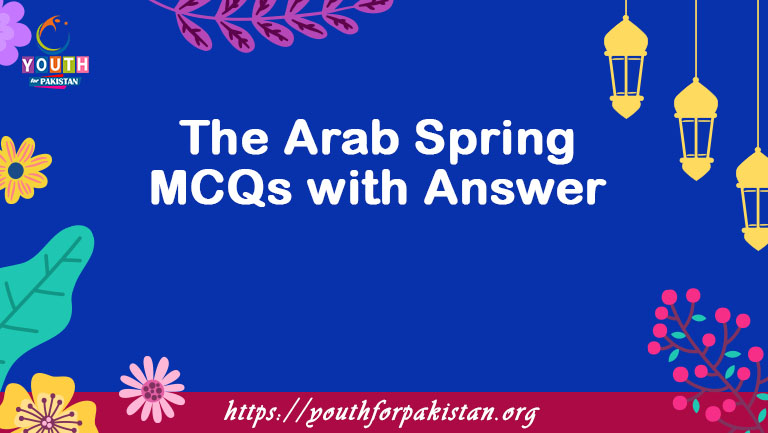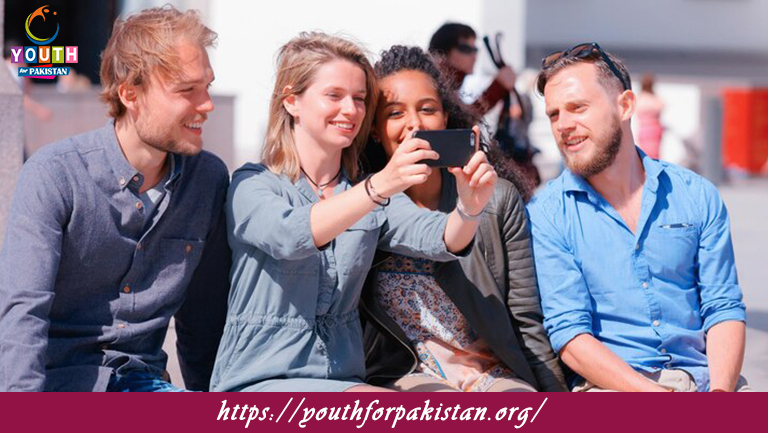The following are The Arab Spring MCQs with answers related to Islamic Studies. We have arranged the most important and repeated MCQs in all the competitive examinations. The students can clear their concepts for The Arab Spring MCQs online quiz by attempting these.
The Arab Spring Online MCQs with Answers
When did the Arab Spring begin?
a) 2000
b) 2005
c) 2010
d) 2015
Which country was the first to witness major protests during the Arab Spring?
a) Egypt
b) Tunisia
c) Libya
d) Syria
What was the primary trigger for the Arab Spring protests?
a) Economic inequality
b) Religious tensions
c) Foreign intervention
d) Environmental issues
Who was the long-serving Tunisian president ousted from power, leading to the start of the Arab Spring?
a) Muammar Gaddafi
b) Hosni Mubarak
c) Zine El Abidine Ben Ali
d) Bashar al-Assad
In which country did the Arab Spring result in a prolonged civil conflict that eventually led to foreign military intervention?
a) Tunisia
b) Egypt
c) Libya
d) Yemen
What social media platform played a significant role in organizing and spreading information about the Arab Spring protests?
a) Facebook
b) Twitter
c) Instagram
d) WhatsApp
Which country’s president, facing mass protests, stepped down after three decades in power during the Arab Spring?
a) Jordan
b) Lebanon
c) Egypt
d) Algeria
What is the term used to describe the series of uprisings, protests, and demonstrations across the Arab world during the Arab Spring?
a) Middle East Revival
b) Arab Awakening
c) Islamic Renaissance
d) Oriental Spring
Which country’s government responded to the Arab Spring protests with violent crackdowns, resulting in widespread casualties?
a) Tunisia
b) Egypt
c) Libya
d) Syria
What was the outcome of the Arab Spring protests in Bahrain?
a) The government implemented major reforms, meeting protesters’ demands.
b) The protests led to a change in government.
c) The government brutally suppressed the protests.
d) The protests resulted in a peaceful transition of power.
What role did the international community, particularly the United Nations, play during the Arab Spring?
a) The United Nations actively intervened in all conflicts.
b) The United Nations imposed sanctions on all affected countries.
c) The United Nations provided humanitarian aid and mediation efforts.
d) The United Nations ignored the Arab Spring protests.
Which country’s leader, Ali Abdullah Saleh, agreed to a transfer of power following protests during the Arab Spring?
a) Egypt
b) Yemen
c) Saudi Arabia
d) Jordan
What was the primary demand of the protesters during the Arab Spring?
a) Regime change
b) Economic reform
c) Greater religious freedom
d) Access to foreign aid
In which North African country did the Arab Spring lead to the rise of an Islamist political party?
a) Tunisia
b) Egypt
c) Algeria
d) Morocco
What was the outcome of the Arab Spring protests in Saudi Arabia?
a) The monarchy implemented major political reforms.
b) The protests led to a change in the monarchy.
c) The protests were swiftly suppressed.
d) The protests resulted in a peaceful transition of power.
Which country’s president, facing widespread protests, sought asylum in Saudi Arabia during the Arab Spring?
a) Tunisia
b) Egypt
c) Yemen
d) Libya
What is the term used to describe the self-immolation of a Tunisian street vendor, which triggered widespread protests and is often seen as the catalyst for the Arab Spring?
a) The Tahrir Square incident
b) The Damascus Declaration
c) The Sidi Bouzid Revolution
d) The Casablanca Uprising
Which country’s leader, Ali Abdullah Saleh, agreed to a transfer of power following protests during the Arab Spring?
a) Egypt
b) Yemen
c) Saudi Arabia
d) Jordan
What was the primary demand of the protesters during the Arab Spring?
a) Regime change
b) Economic reform
c) Greater religious freedom
d) Access to foreign aid
In which North African country did the Arab Spring lead to the rise of an Islamist political party?
a) Tunisia
b) Egypt
c) Algeria
d) Morocco
What was the outcome of the Arab Spring protests in Saudi Arabia?
a) The monarchy implemented major political reforms.
b) The protests led to a change in the monarchy.
c) The protests were swiftly suppressed.
d) The protests resulted in a peaceful transition of power.
Which country’s president, facing widespread protests, sought asylum in Saudi Arabia during the Arab Spring?
a) Tunisia
b) Egypt
c) Yemen
d) Libya
What is the term used to describe the self-immolation of a Tunisian street vendor, which triggered widespread protests and is often seen as the catalyst for the Arab Spring?
a) The Tahrir Square incident
b) The Damascus Declaration
c) The Sidi Bouzid Revolution
d) The Casablanca Uprising
Which Middle Eastern country experienced protests that called for political and economic reform but did not result in a regime change during the Arab Spring?
a) Syria
b) Jordan
c) Libya
d) Lebanon
What was the impact of the Arab Spring on the Syrian civil conflict?
a) The Arab Spring had no impact on the Syrian conflict.
b) The Arab Spring directly led to the Syrian conflict.
c) The Syrian conflict predates the Arab Spring.
d) The Arab Spring resolved the Syrian conflict peacefully.
In which country did the Arab Spring result in a power-sharing agreement between the monarchy and opposition groups?
a) Egypt
b) Tunisia
c) Yemen
d) Morocco
What role did social media platforms play in organizing and spreading information about the Arab Spring protests?
a) They had no significant role in the protests.
b) They played a crucial role in organizing and sharing information.
c) They were actively used by governments to suppress protests.
d) They were banned during the Arab Spring.
Which Arab Spring country experienced a successful democratic transition with the election of a new government?
a) Egypt
b) Libya
c) Tunisia
d) Syria
What is the term used to describe the ongoing instability, conflict, and violence that followed the Arab Spring in many affected countries?
a) Arab Winter
b) Arab Summer
c) Arab Peace
d) Arab Renaissance
How did the Arab Spring impact the political landscape of many Arab countries?
a) It led to a consolidation of authoritarian rule.
b) It resulted in the establishment of stable democracies.
c) It triggered political reforms and increased civil liberties.
d) It had no impact on political systems.
What was the role of international media during the Arab Spring protests?
a) International media largely ignored the protests.
b) International media played a crucial role in covering and reporting on the protests.
c) International media actively supported the governments against the protesters.
d) International media was banned from covering the protests.
What was the primary outcome of the Arab Spring protests in Algeria?
a) The protests led to a peaceful transition of power.
b) The government brutally suppressed the protests.
c) The protests resulted in a change in government.
d) The protests had no significant impact in Algeria.
Which country’s monarchy agreed to constitutional reforms following protests during the Arab Spring?
a) Saudi Arabia
b) Morocco
c) Bahrain
d) Qatar
What was the outcome of the Arab Spring protests in Kuwait?
a) The protests resulted in a change of the monarchy.
b) The government implemented major political reforms.
c) The protests led to a peaceful transition of power.
d) The protests were swiftly suppressed.
Which Arab Spring country experienced a transition from dictatorship to democracy but later faced political instability and violence?
a) Egypt
b) Libya
c) Tunisia
d) Syria
In which country did the Arab Spring result in a power-sharing agreement between the monarchy and opposition groups?
a) Egypt
b) Tunisia
c) Yemen
d) Morocco
What role did social media platforms play in organizing and spreading information about the Arab Spring protests?
a) They had no significant role in the protests.
b) They played a crucial role in organizing and sharing information.
c) They were actively used by governments to suppress protests.
d) They were banned during the Arab Spring.
Which Arab Spring country experienced a successful democratic transition with the election of a new government?
a) Egypt
b) Libya
c) Tunisia
d) Syria
What is the term used to describe the ongoing instability, conflict, and violence that followed the Arab Spring in many affected countries?
a) Arab Winter
b) Arab Summer
c) Arab Peace
d) Arab Renaissance
How did the Arab Spring impact the political landscape of many Arab countries?
a) It led to a consolidation of authoritarian rule.
b) It resulted in the establishment of stable democracies.
c) It triggered political reforms and increased civil liberties.
d) It had no impact on political systems.
What was the role of international media during the Arab Spring protests?
a) International media largely ignored the protests.
b) International media played a crucial role in covering and reporting on the protests.
c) International media actively supported the governments against the protesters.
d) International media was banned from covering the protests.
What was the primary outcome of the Arab Spring protests in Algeria?
a) The protests led to a peaceful transition of power.
b) The government brutally suppressed the protests.
c) The protests resulted in a change in government.
d) The protests had no significant impact in Algeria.
Which country’s monarchy agreed to constitutional reforms following protests during the Arab Spring?
a) Saudi Arabia
b) Morocco
c) Bahrain
d) Qatar
What was the outcome of the Arab Spring protests in Kuwait?
a) The protests resulted in a change of the monarchy.
b) The government implemented major political reforms.
c) The protests led to a peaceful transition of power.
d) The protests were swiftly suppressed.
Which Arab Spring country experienced a transition from dictatorship to democracy but later faced political instability and violence?
a) Egypt
b) Libya
c) Tunisia
d) Syria
What was the impact of the Arab Spring on the political situation in Iraq?
a) Iraq experienced a peaceful transition to democracy.
b) Iraq remained unaffected by the Arab Spring protests.
c) Iraq faced increased instability and sectarian violence.
d) Iraq became a stronghold of democracy in the region.
Which Arab Spring country witnessed a significant increase in sectarian tensions and violence between Sunni and Shia Muslims?
a) Tunisia
b) Libya
c) Egypt
d) Bahrain
What is the current status of the Arab Spring movements as of 2021?
a) The movements have achieved their goals and are thriving.
b) The movements have completely disbanded.
c) Some movements succeeded, while others led to ongoing conflicts and instability.
d) The movements have transitioned into peaceful political parties.
What role did youth and social activists play in the Arab Spring protests?
a) They had no involvement in the protests.
b) They were the primary organizers and participants in the protests.
c) They supported the governments against the protesters.
d) They were not significant actors in the protests.
What impact did the Arab Spring have on the broader political and social landscape of the Middle East and North Africa region?
a) It led to regional stability and cooperation.
b) It triggered ongoing conflicts and changes in leadership.
c) It resulted in a return to authoritarian rule in all affected countries.
d) It had no lasting impact on the region.










